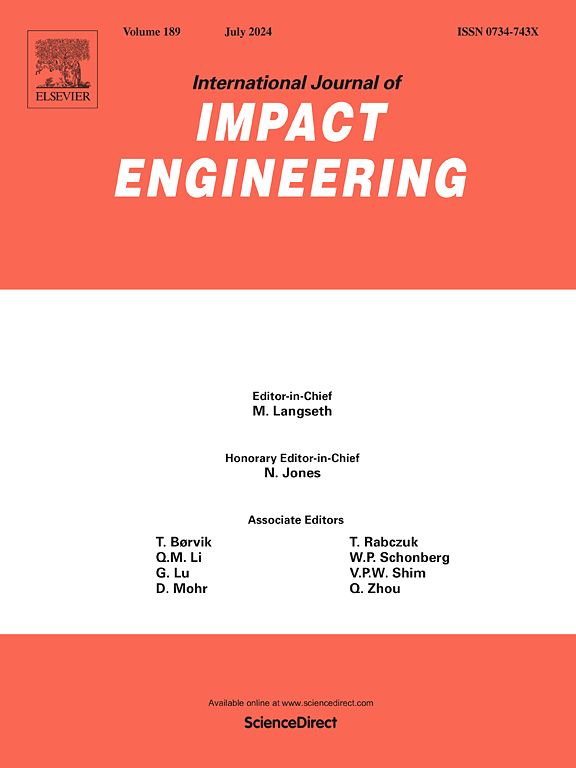考虑应变硬化、应变速率和温度效应的刚性弹丸侵彻金属目标的理论模型
IF 5.1
2区 工程技术
Q1 ENGINEERING, MECHANICAL
International Journal of Impact Engineering
Pub Date : 2025-06-29
DOI:10.1016/j.ijimpeng.2025.105436
引用次数: 0
摘要
在本研究中,我们提出了一个包含应变硬化、应变速率和温度耦合效应的理论侵彻模型,该模型适用于在特定的冲击速度范围内,在正常冲击下穿透铝目标的刚性凸鼻长杆钢弹丸。首先,我们采用显式应力-塑性应变关系来准确表征塑性区域的流动应力。这有助于导出不可压缩球腔动态膨胀的近似解,并分析应变速率和温度软化对球腔径向应力的影响。随后,我们利用球腔扩张(SCE)近似,并结合时变速度边界条件,推导出闭式侵彻方程。通过对三种口径半径头(CRH)凸鼻长杆弹打击铝靶的最终侵彻深度实验数据进行比较,验证了该模型的有效性。此外,我们还进行了非线性有限元模拟,以确定Johnson-Cook本构关系中不同分量对目标侵彻阻力的影响。最后,基于CRH和速度的变化,分析了热软化对侵彻阻力的影响。结果表明,应变率效应增强了靶材的电阻,特别是对应变率敏感材料。或者,热软化效应降低了靶材的阻力。热软化对塑性区域内靶板影响显著,其中1<;r(x)/a(x)<2;然而,它对其他塑料区域的影响相对较小。弹面速度法向分量随着CRH的增大而逐渐减小,从而使热软化效应减弱。相反,应变速率随初速度的增大而增大。这表明温度进一步升高,加剧了热软化,从而导致穿透阻力降低约5.4%至6.1%,并降低了目标板材料的空化阻力。本文章由计算机程序翻译,如有差异,请以英文原文为准。
Theoretical model of rigid projectile penetration into metal targets considering strain hardening, strain rate, and temperature effects
In this study, we present a theoretical penetration model that incorporates the coupled effects of strain hardening, strain rate, and temperature, applicable to rigid ogive-nose long rod steel projectiles that penetrate aluminium targets under a normal impact within a specific range of striking velocities. Firstly, we employ an explicit stress–plastic strain relationship to accurately characterise the flow stress in the plastic region. This helps derive the approximate solution for the dynamic expansion of the incompressible spherical cavity, and analyse the effects of the strain rate and temperature softening on the radial stress of the spherical cavity. Subsequently, we derived the closed-form penetration equation using the spherical cavity expansion (SCE) approximation and by incorporating time-dependent velocity boundary conditions. The proposed method is then employed to validate the model by comparing the results obtained from the proposed SCE approximation penetration model with the existing experimental data derived from the final depth of penetration of three caliber-radius-head (CRH) ogive-nose long rod projectiles used to strike aluminium targets. Furthermore, we performed nonlinear finite element simulations to determine the importance of different components of the Johnson–Cook constitutive relationship in affecting the penetration resistance of the target. Lastly, we analysed the effect of thermal softening on the penetration resistance based on the variations in CRH and velocities. The results indicate that the strain rate effect enhances the resistance of the target, particularly for the strain-rate sensitive materials. Alternatively, the thermal softening effect reduces the resistance of the target. The thermal softening significantly affects the target plate within the plastic region, where ; however, its influence in other plastic regions is relatively minimal. The normal component of velocity at the projectile surface decreases progressively with the increase in the CRH, thereby attenuating the effect of thermal softening. Conversely, the strain rate increases with the increase in the initial velocity. This presents a further increase in the temperature, which exacerbates thermal softening, thereby causing a reduction in the penetration resistance by approximately 5.4% to 6.1% and diminishing the cavitation resistance of the target plate material.
求助全文
通过发布文献求助,成功后即可免费获取论文全文。
去求助
来源期刊

International Journal of Impact Engineering
工程技术-工程:机械
CiteScore
8.70
自引率
13.70%
发文量
241
审稿时长
52 days
期刊介绍:
The International Journal of Impact Engineering, established in 1983 publishes original research findings related to the response of structures, components and materials subjected to impact, blast and high-rate loading. Areas relevant to the journal encompass the following general topics and those associated with them:
-Behaviour and failure of structures and materials under impact and blast loading
-Systems for protection and absorption of impact and blast loading
-Terminal ballistics
-Dynamic behaviour and failure of materials including plasticity and fracture
-Stress waves
-Structural crashworthiness
-High-rate mechanical and forming processes
-Impact, blast and high-rate loading/measurement techniques and their applications
 求助内容:
求助内容: 应助结果提醒方式:
应助结果提醒方式:


